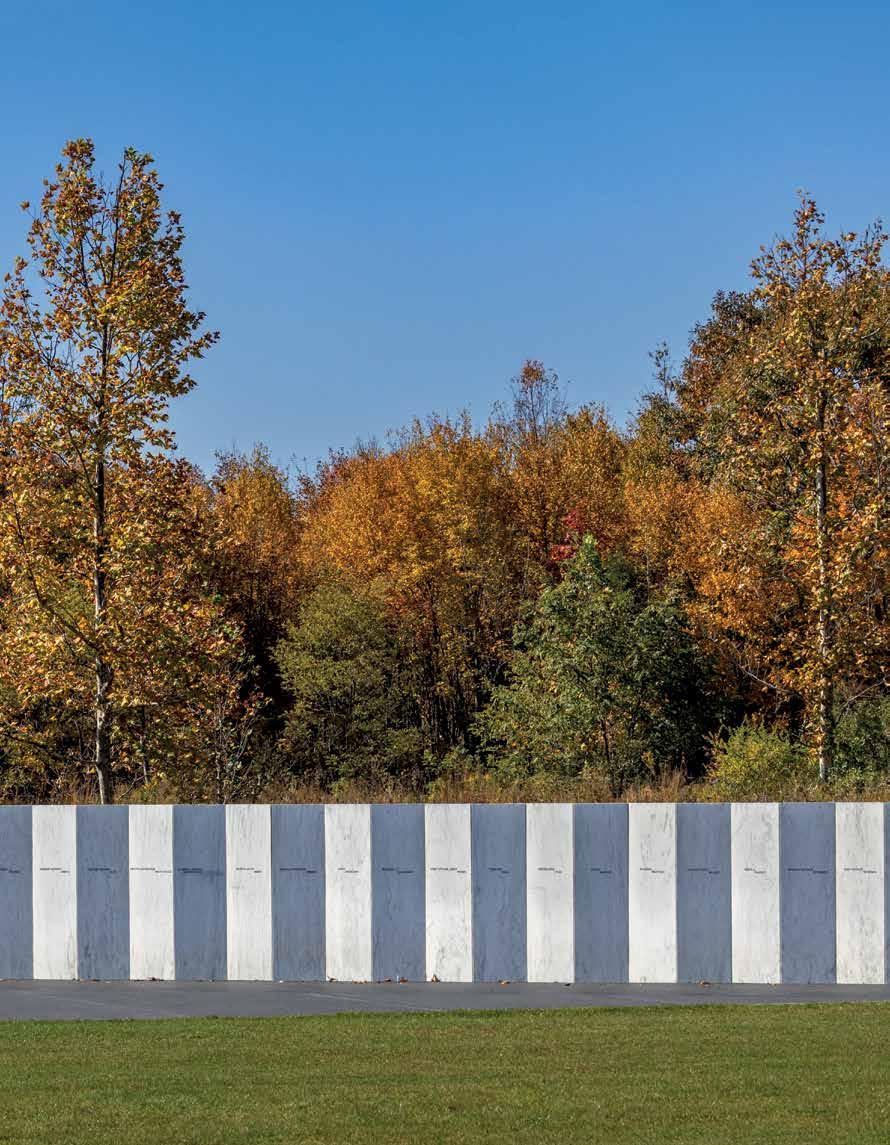
PAUL MURDOCH ARCHITECTS FLIGHT 93 NATIONAL MEMORIAL
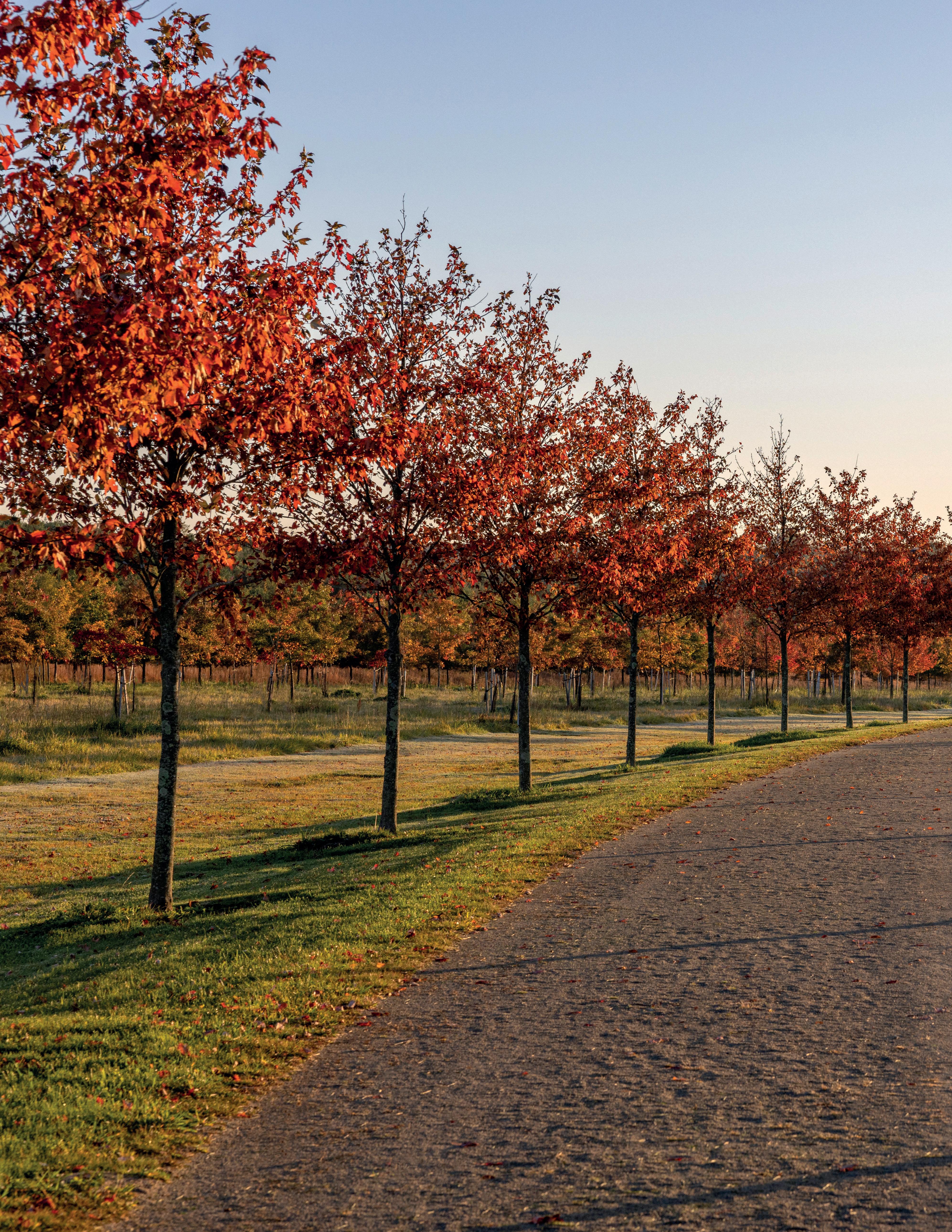
On the morning of September 11, 2001, at the beginning of my sophomore year at a Connecticut boarding school, the entire student body was called into an emergency allschool assembly. Two commercial planes had hit the North and South Towers of the World Trade Center in New York City, we were told. Soon, we learned that both towers had collapsed, and that two other planes had also been hijacked and crashed, one of them colliding with the Pentagon in Washington, D.C., and the other—United Airlines Flight 93—careening into a field and hemlock grove near Shanksville, Pennsylvania. I’ll never forget seeing, a short time later, the video footage of Lower Manhattan covered in a dense cloud of debris and smoke, bloodied and soot-covered pedestrians running away from the wreckage, firemen and rescue workers rushing in to help. The fireball of the second plane hitting the South Tower was replayed over and over.
I can’t remember exactly what I felt that day—I was only 16 years old. But I do know the experience was surreal and, as it was for so many, dissociative: Are we really seeing this? Is this actually happening? How do we make sense of this? Can we make sense of this?
Because of my own experience as a plane crash survivor, 9/11 was doubly complex—an international tragedy of unfathomable magnitude that I could somehow, in my own small, roundabout way, relate with. As soon as I heard the news about the planes hitting the towers, the Pentagon, and the Shanksville land, I thought of each of the passengers on board and those in the buildings. The lives lost, their families, their friends. The survivors. The rescuers. The devastation and destruction. The void. The grief. The trauma.
I had survived the crash-landing of United Airlines Flight 232 on July 19, 1989, when the titanium fan disk of a DC-10 carrying 296 people from Denver to Chicago exploded at 37,000 feet in the air, puncturing the aircraft and cutting all of its hydraulic lines. With the jet nearly impossible to steer, the captain, Al Haynes, was forced to bring the plane down, in huge sweeping turns, to the nearest runway, at Sioux Gateway Airport in Sioux City, Iowa. There, the plane hit the ground, instantly igniting; its right wing tore off, and the fuselage, barreling along Runway 22 and into a surrounding cornfield, ripped into several pieces. One hundred twelve people, including my mom, died; one hundred eighty-four, including my brother Brandon and me, survived. I was in a coma for three days and have no memory of the event.
A woman, Lynn Hartter, found my limp body in the wreckage, passing me off to Lt. Col. Dennis Nielsen, of the Air National Guard. A photographer at the scene, Gary Anderson, captured Nielsen carrying me in that humbling moment of heroism. The image was broadcast on TV around the world and appeared on the front pages of newspapers and magazines, including the July 31, 1989, cover of Time. Five years later, in 1994, the picture was turned into a bronze statue—the centerpiece of the Flight 232 “Spirit of Siouxland” memorial located along the Missouri River in Sioux City.
Seeing that statue was—and remains today—bizarre. I do not see myself in it. It’s me, but it’s not actually me. A sort of biblical symbol, the statue presents a hero narrative lacking in plural meaning, designed to tell a singular angle of a much more dynamic and complex story.
FLIGHT 93 NATIONAL MEMORIAL 03

PAUL MURDOCH ARCHITECTS 06
FLIGHT 93 NATIONAL
MEMORIAL
PENNSYLVANIA, UNITED STATES OF AMERICA 2005 - 2020
The Flight 93 National Memorial is a new 2,200-acre national park at the site in Western Pennsylvania where United Flight 93 crashed on September 11, 2001. The first 21st century U.S. national park transforms the site, formerly a coal mine, into a designed memorial landscape that commemorates the 40 heroes on Flight 93 who gave their lives thwarting a terrorist attack on the U.S. capital.
The design was selected among 1,100 entries through a two-stage, international design competition in 2005. In the first stage, Paul Murdoch Architects presented a master plan with key memorial features, such as a tower with 40 wind chimes, a large curving landform with memorial trees framing a field of honor, long tall memorial walls that frame the flight path and enclose a visitor center, and a memorial plaza along the edge of the crash site, culminating in a ceremonial gate and wall of names. In the second stage, a team of consultants helped develop the design concept, including an association with Nelson Byrd Woltz Landscape Architects.
The memorial design enhances the qualities and physical features of the site for its expressive power. The experience of moving through a restored site of varied characteristics, including along the crash site – now hallowed ground; around a former strip mine – now a native meadow and field of honor (a common field one day…a field of honor forever); and over wetlands – now part of a storm water system, uses healing of the land to reflect the growth and healing possible for people who come visit this place. It focuses visitors’ attention on the crash site and presents a variety of open space experiences developed over fifteen years through several phases of a master plan.
The first phase, dedicated on 9/10/2011, includes an entry road, re-grading of the large field of honor, and memorial features adjacent to the crash site. The second phase, dedicated on 9/10/2015, includes a new visitor center with enclosing memorial walls, a flight path walkway, a learning center and a pedestrian bridge over restored wetlands.
The visitor center is located between two ascending concrete memorial walls where the flight path crosses the edge of a large bowl-shaped field that was formerly an openpit coal mine. The large site walls conceal approaching views of the Field of Honor. A walkway aligned with the flight path orients visitors to the direction of the plane overhead on 9/11 and leads through tall narrow portals to an overlook of the expansive field and crash site below. From the visitor center, a walk east through the formal alle or west down a meandering path leads to the edge of the crash site and wall of inscribed names of the passengers and crew.
The plane crashed at the edge of this open field in front of a grove of hemlock trees, burning many of the trees. This hemlock grove is the backdrop to the crash site, the focal point for the entire memorial experience. The distinct structure of the trees, with a straight, tall trunk and alternating angled branches, is the inspiration for the design motif expressed in materials throughout the memorial.
To keep the modestly sized visitor center interior from becoming cluttered and overwhelming, displays are limited to five double-sided, freestanding exhibit walls. Archival exhibit material that is sensitive to natural light is protected by careful location of building apertures and high-performance glazing of various types, thereby allowing the interior to be visually connected with the memorial landscape. The interior wall facing the crash site features black-stained precast concrete panels with a hand-hewn hemlock finish, thus recalling the charred hemlock trees burned by the crash.
The final major phase, completed in 2020, features the Tower of Voices, a monumental, 93-feet tall musical instrument holding 40 wind chimes, commemorating the 40 passengers and crewmembers on the plane. As a gateway landmark, it is the primary memorial feature near the entrance to the park and a living memorial in sound to remember the 40 through their ongoing voices.
As a unique musical feature, the tower required an interactive design process of testing and simulation involving musical tuning theory to establish the right tones, chime mock-ups for 3D recordings and movement testing, computational fluid dynamic modeling to test tower shapes, and acoustic simulation in a sound lab to digitally test chime resonance and combinations.
PAUL MURDOCH ARCHITECTS
07


PAUL MURDOCH ARCHITECTS 10 N 0 50 150
FLIGHT 93 NATIONAL MEMORIAL 11 TOWER OF VOICES SACRED GROUND VISITOR CENTER AND MEMORIAL WALL

PAUL MURDOCH ARCHITECTS 14

FLIGHT 93 NATIONAL MEMORIAL 15
PAUL MURDOCH ARCHITECTS 20
FLIGHT 93 NATIONAL MEMORIAL 21 BENCH ELEVATION A BENCH PLAN A 0 1 0.25
PAUL MURDOCH ARCHITECTS 22 BENCH SECTION A 0 1 0.25

FLIGHT 93 NATIONAL MEMORIAL 23

PAUL MURDOCH ARCHITECTS 26






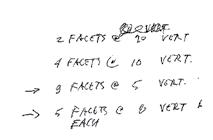
FLIGHT 93 NATIONAL MEMORIAL 27

PAUL MURDOCH ARCHITECTS 32

FLIGHT 93 NATIONAL MEMORIAL 33
PAUL MURDOCH ARCHITECTS 36 VISITOR CENTER FLIGHT PATH OVERLOOK LEARNING CENTER AND COMFORT STATION N 0 150 50


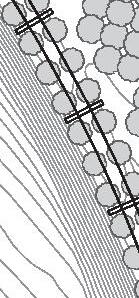
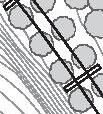
FLIGHT 93 NATIONAL MEMORIAL 37

PAUL MURDOCH ARCHITECTS 46

FLIGHT 93 NATIONAL MEMORIAL 47

PAUL MURDOCH ARCHITECTS 54

FLIGHT 93 NATIONAL MEMORIAL 55
PAUL MURDOCH ARCHITECTS 60 TOWER OF VOICES N 0 150 50
FLIGHT 93 NATIONAL MEMORIAL 61
PAUL MURDOCH ARCHITECTS 62

FLIGHT 93 NATIONAL MEMORIAL 63
PAUL MURDOCH ARCHITECTS 72

FLIGHT 93 NATIONAL MEMORIAL 73
PAUL MURDOCH ARCHITECTS 74 01 Anchorage plate + bar 02 Universal joint 03 Upper suspension rod 04 Node bar and puck 05 Universal joint 06 Chime 07 Lower suspension rod 08 Striker with damper 09 Rotator 10 Sail 11 Tether 12 Corbel 13 Tower structure 1 0.25 0
FLIGHT 93 NATIONAL MEMORIAL 75 TOWER OF VOICES BELL DETAIL



PAUL MURDOCH ARCHITECTS 80
FEATURED WORK FLIGHT 93 NATIONAL MEMORIAL PENNSYLVANIA
UNITED STATES OF AMERICA
2005-2020
DESIGN TEAM - PHASE I
2005 - 2011
Architect
Paul Murdoch Architects
Landscape Architect
Nelson Byrd Woltz Landscape Architects
Civil Engineer
The Eads Group
Civil Engineer RBA Partners
Structural Engineer Sato & Boppana
MEP Engineer HF Lenz Company
Lighting Design George Sexton & Associates
Graphic Design Impact Design Associates
Typography Design Ana Llorente
Security Design Sako & Associates
Cost Consultant Davis Langdon
Specifications
Capital Specs
Image Credits Drawings
Paul Murdoch Architects
Renderings
bioLINIA & Paul Murdoch Architects
Paul Murdoch Architects
Paul Murdoch, Milena Murdoch, Eric
Cunningham, Kin Lee, Charles Lee, Victor Garcia
DESIGN TEAM - PHASE II
2011 - 2015
Architect
Paul Murdoch Architects
Landscape Architect Nelson Byrd Woltz Landscape Architects
Civil Engineer HF Lenz Company
Geotechnical Engineer Garvin Boward Beitko
Structural Engineer Silman
MEP Engineer HF Lenz Company
Lighting Design George Sexton & Associates
Graphic Design Linespace
Security Design Sako & Associates
Cost Consultant Davis Langdon Adamson
Exhibit Design Gallagher & Associates
LEED Zinner Consultants
Specifications Chew Specifications
Constructability Yuk Chan
Image Credits Drawings
Paul Murdoch Architects
Renderings
bioLINIA & Paul Murdoch Architects
Paul Murdoch Architects
Paul Murdoch, Milena Murdoch, Eric Cunningham, Dean Perton, Kin Lee, Victor Garcia, Charles Lee, Will Longyear, Peter Rindelaub, Chris Feldman, Juan Garcia, Luv Khot
FLIGHT 93 NATIONAL MEMORIAL 81

































